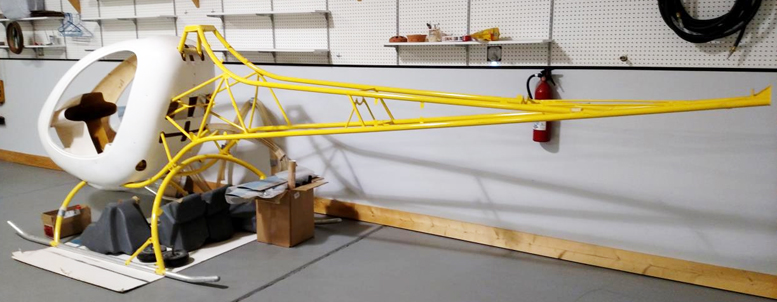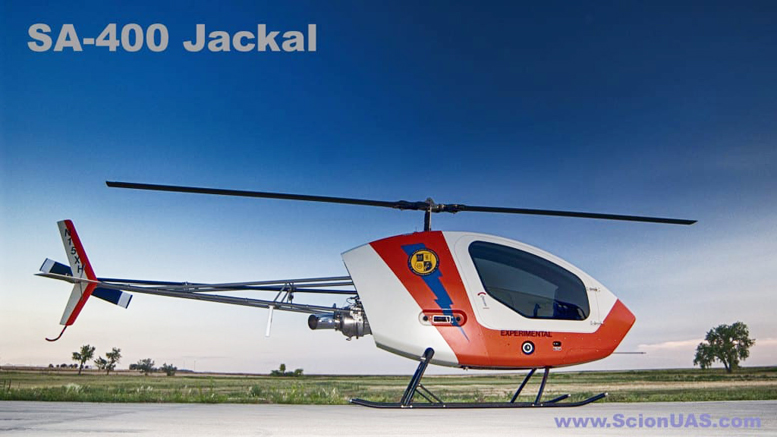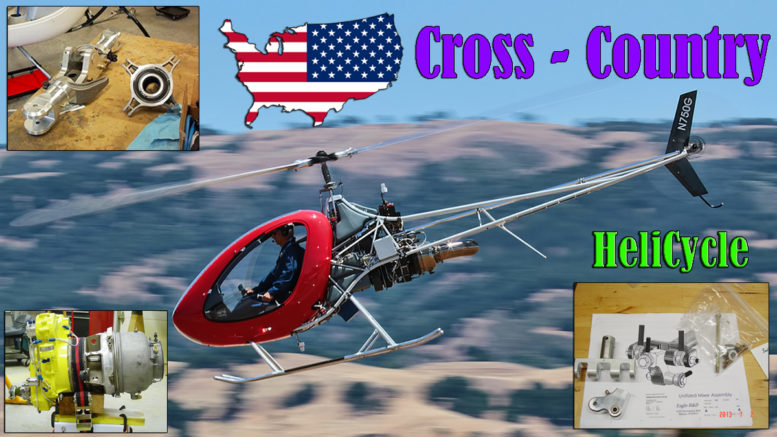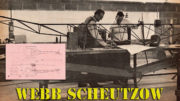Not long after completing construction and certification of my Helicycle, the idea came up about flying cross-country to the helicopter fly-in and meet at Homer Bell’s in Hillsboro, Ohio. Kathy, my fiancee, gave her complete support giving me confidence to continue planning. The trip would be 725 statute miles, straight line one way.
It was just 20 days before the meet when planning began and the Helicycle still had about 20 hours remaining to be flown off the 40-hour/25-mile restriction. That meant that I needed to fly a lot. Twist my arm! Baton Rouge Metropolitan Airport is 23 miles away, and several flights there gave me practice in helicopter/airport etiquette and refueling off the fuel truck.
Many mornings I would crank up and fly 16 miles to a friend’s home for coffee. Kathy would audit the time on the ship and prod me to keep flying. I would fly out to the 25-mile radius and do a “DME arc”, then fly back home. Many of my other friends got visits from the Helicycle. On the morning of the flight to Homer’s, there was 40.5 hours on the Hobbs meter and the ship was signed off!
During that fly-off time, both the ship’s fuel consumption and airspeeds were evaluated. I do not have a fuel flow meter on the ship or even on my truck bed fuel dispenser. Several flights of 1.5 hours all showed l/8th tank on the gauge and in the sight tube; no problem averaging 100 MPH either. That convinced me that 100-mile legs would be doable.
Planning the legs, I picked out small airports that listed Jet-A and called the FBOs at each to insure they had the round nozzle. Leg distances were 90 to 119 miles.While doing high-speed flights, the half-doors became attractive, so these were made and installed.
Knowing the need for fuel nozzle adapters and a storage place, I made two boxes that fit into the space beneath the seat pan and on each side of the cyclic control rods. (Note: the Helicycle fuel-filler port was designed for avgas when the kit was sold with a four-stroke engine, a round Jet-A nozzle is too big and an adapter is needed. A short length of bicycle inner tube works)
Things that rode in the storage boxes beneath the seats: 2 feet of bicycle inner tube for fuel nozzle adapters, a crescent wrench, a Leatherman tool, five-minute epoxy, tie wraps, thin plastic sheeting to cover the ship, paper binder clips to hold the sheeting on, and a quart Ziploc bag used as an “overnighter” containing clean shirt, underwear and a disposable toothbrush and razor. My travel bag was shipped ahead by UPS, after calling Homer to confirm.

On the morning of the first leg, dealing with the few last minute details, I did not depart until 11:00 a.m. After a nice wave-off from Kathy and the dogs, I headed north. Knowing the Helicycle turbine burned just as much fuel doing 40 MPH as it does doing 100 MPH; the plan was to push the ship for speed.
Experience during the past 40 hours, showed that the little ship does not mind going fast. The elastomeric bearings want to keep the collective pulled in to about 90 MPH but a little more pull yielded a steady 105 MPH.
First, 12 miles across Louisiana and then into Mississippi. The Garmin 496 kept track of the miles and time to go to the next destination. Between that, the fuel gauge, temperature gauge and fuel gauge again, I watched my flight progress, knowing that the bird could fly 15 minutes from each quarter tank.
With 30 minutes time into the first leg, a fuel gauge showing just slightly less than 3/4 tank, I had confidence. At 10 miles out from the first stop, the fuel gauge was going below 1/4. On approach to the fueling pad, the tank was at 1/8, and on shutdown it was a needle width off empty. This was cutting it a little close.
At the first fuel stop, Williams Airport near Jackson, Mississippi, the Helicycle attracted quite a few spectators. One of the first people there asked if it was a Helicycle, I was impressed.
Michele Jackson, the airport manager walked up with the round adapter to replace the duckbill for the fuel nozzle and the first thing she said was in reference to a “B.J. Schramm design”. I was impressed again. I told her that I was going to Homer’s and she said that she had been there several times.
With the first stop under my belt a review of the fuel usage was done. It took 17.8 gallons to top off the tanks for that first 106-mile leg. It was 119 miles to the next planned stop and I was not going to push it. A diversion was necessary so I picked KMPE, 82 miles away.
Jackson approach provided VFR flight following until I got out of their area, which was a lot of help. They pointed out several aircraft including a med-evac helicopter at my altitude. A nice tailwind increased throughout the day.
After refueling at KMPE, my route took me directly through Columbus, Mississippi’s Class-C airspace. It seemed that there was a trainee on approach control and I was given vectors the long way around the airspace. Then an older sounding controller came on and said there was some confusion about my destination.
This may explain the vectored “long way around”. All of that said, I was not going to make my next planned fuel stop. Noticing an airport just to the east of Columbus’ airspace, the Garmin 496 and a call to Unicom confirmed it as my next Jet-A fuel stop.
Here a problem arose. I had been using the same length of bicycle tube as an adapter and it developed a leak. It seems the fuel softened the rubber. The extra inner tube that I packed came in handy. The next leg was boogiddy-boogiddy (Editors note: This noise usually means that his constrahedous must have been rubbing on the macvalcy) to Muscle Shoals, Alabama. It was a good flight.
Departing KMSL, the route took me over the beautiful Tennessee hills to Murfreesboro where I would spend the night. Talk about great service. At the FBO, the person who closed up took me to a hotel and arranged for the person who opened up the next morning to come by and pick me up.
I had a learning point at KMBT — taxi and park first, then refuel immediately before departure. I did it the other way and worried about the fuel burned out of the full tanks in the few minutes of hovering to the parking spot.
The sixth leg took me to Taylor Country Airport. Fuel burn was foremost on my mind. The gauge was really low as during hover taxiing to the fuel pump. I wished I had an accurate fuel totalizer.

Rigging up a funnel at Russellville, Alabama.
After topping off the tanks, I calculated that there was a whopping 15 minutes (3.5 gals.) left in the tanks when I landed. Thirty years of fixed wing flying did not prepare me for this aspect of rotary wing flying.
The seventh leg brought me through Lexington, Kentucky’s approach control airspace where friendly VFR flight following helped me right along and over the breath-taking horse ranches north of the city. One gets a wonderful feeling when seeing beautiful things, which is what I got flying over Tennessee and Kentucky. Traveling across our country at 500 feet above ground level is a rewarding experience.
The next destination/fuel stop would get me 40 miles from the final destination, Homer’s. There was a line of storms going east and west, right over that last 40 miles. A Kentucky State Police helicopter crew and I both rode out two heavy showers while refueling at Mason County Airport.
The thin plastic sheet and binder clips I had packed made a great rain poncho for the Helicycle. After watching the radar in the FBO, I saw a break that might get me to Homer’s so I departed. That flight got me 20 miles closer before a dark gray storm filling the horizon convinced me to land in at the Georgetown, Ohio airport.
Two airport residents came to check on me. The second, Mike Inskeep, came with a report of a severe storm bearing down on the airport and an invitation to put the Helicycle into his hangar. I accepted.
Mike used his lawn tractor to skid the Helicycle across the grass and up to the hangar and then we used broom handles to roll it inside. This is a good testament to install lightweight flying wheels for ground handling when going cross country.
Mike gave me a ride into the town where I had my hotel reservation and I could get a rental car. I then drove to Homer Bell’s. I checked in with the gracious Sharon Bell and she had my luggage that UPS had delivered.
I was not expecting the reception that I got. Many people were amazed that a Helicycle was flown cross-country. Others knew I was making the trip and were glad that I had arrived. Jeff Keener offered to fly me in his Robinson R22, back to the Georgetown airport the next morning to get my Helicycle.
The Helicycle made it to Homer’s that next morning. There were more congratulations about me completing the trip. To the best of anyone’s knowledge, this was the longest cross country trip that a Helicycle had made; a testimony to the reliability of the ship’s design.

The Helicycle Gang at Homer’s
Friday at Homer’s there was plenty of looking at helicopters, hangar talk and flying. We had a four Helicycle fly-out for sandwiches at a deli five miles away. Then it was off to the night at a local steak house topped off the day. Thanks Mike Belcher.
Saturday’s weather was fantastic; the air was crystal clear and cool with a steady wind from the north. The four-ship Helicycle gang conspired on a trip to Batavia, Ohio, Claremont County airport, for hotdogs at Sporty’s. We practiced some formation flying on the return trip to Homer’s. That was a bunch of fun.

Formation send-off for Jim departing Homer’s for trip back home.
There was a high-pressure weather system over Illinois creating a great tailwind to take advantage of and start my trip back home. After fighting off urges to fly northeast to Oshkosh, I decided to pack up and head south. It was Saturday evening around four pm and there was plenty of daylight left.
While getting the Helicycle ready for the flight, I found myself surrounded by about 20 people! The entire Helicycle contingent had gathered to present me a card signed by all and a gift for recognition of what to-date was the longest cross-country trip in a Helicycle. I was honored. Thanks to all.
I guess the formation flying that we had been doing has started a tradition. As I was preparing to depart, Joe Loxtercamp came up and said that the Helicycle gang wanted to escort my departure with a formation flight. We briefed on the procedure and lifted off.
It was a five ship formation and I was right wing. The formation flew out and as it circled back over Bell Air Ranch, I left formation with a right break and headed home. The formation then circled back with the missing man. Again, I was honored.
The tailwind was a big help. The cross-country flying was great with unrestricted visibility. Lexington, Kentucky was my first fuel stop. While at the FBO, I visited with a Med-evac helicopter crew and planned Bowling Green as my next fuel stop and where I would spend the night.
Getting to BWG was another stretch on the fuel. As I made the approach and landed on the ramp, the fuel gauge needle was just about to touch the empty mark. The lineman met me with the fuel truck and I pulled out the inner tube fuel nozzle adapter and started to refuel the thirsty Helicycle.
After putting about five gallons in the tanks, the rubber adapter blew off the nozzle end, sprayed fuel all over me and the helicopter and then the adapter ended up inside the tank! This is just one of the reasons that I do not like to rig things.
The fuel wiped up easily and I was able to fish the link of inner tube out of the fuel tank with a straightened coat hanger. The biggest problem left was the stink of jet fuel on me. I cleaned up just fine after a ride to the hotel.
The next morning, the journey home continued. The next stop was Shelbyville, Tennessee. All went well there except my cell phone ran out of charge. I had to call home on a toll phone! There was an internet-connected computer at the FBO and I was able to file a trip report with the Helicycle Group.
Russellville, Alabama had fuel at a good price so that was my next stop. It was another beautiful flight. Flying cross country in your personal helicopter is an experience for which I am thankful. Real world issues came up on landing at Russellville.
The Jet-A self-serve pump had a duckbill nozzle and my inner-tube adapter would not stretch over it. It was Sunday, the FBO was closed and the airport was deserted. I was able to cut the bottom out of an aviation oil container and tie it up at the correct angle on the Helicycle fuel tank so I could stand on the courtesy stepladder and drizzle in almost 20 gallons.
Did I mention that I do not like to rig things? In addition, my planning got lax on the return trip. I should have known that the FBO is closed on Sunday. Starkville, Mississippi was the next stop. Good service is common at most airports but sometimes it seems that getting service is a bother. That is what it seemed like at the Mississippi State flagship airport. Go Dawgs.
Cross-country flying was getting to feel comfortable. I did have to consciously keep complacency at bay. The last fuel stop before home was again at Williams Airport near Jackson, Mississippi. They were friendly and helpful as on the trip out bound.
There is an abandoned microwave relay tower that is less than a mile from my home and I use it as a visual homing beacon. It was a comfortable sight to see it on the horizon. My approach to home was from a different direction that I was familiar with and I was on top of my Sky Ranch before I knew it. I landed and the trip to Homer’s was over!
It was an adventure of a lifetime; flying a helicopter that I had made, cross-country over 1500 miles, making new friends and seeing wonderful sights. I want to thank my fiancee Kathy and all my new Helicycle friends for their support and encouragement.
Jim Little

Random stuff…









Good article on x-country. Want to buy a used Helicycles or maybe a Mosquito. Thanks.
lol XC in 1 hour legs in a single seat helicopter, that must’ve been somewhat uncomfortable but a fun challenge nonetheless. Unfortunately it looks like Eagle R&D went under and the only support comes from the community that remains. Mosquito is probably your best bet as they still have a full supply chain and are operational.
I’ve often wondered about flying cross-country in a helicopter of that size. There is no trim or hydraulic assistance, little room to stretch the legs, and limited fuel – I guess if you build-up to longer flights it may work but agreed, a little uncomfortable over such a long journey. I just remembered, a number of years back, a CH7 Kompress flew from Europe to the States across open ocean with extra fuel loaded in the tandem seat, now that’s just crazy!